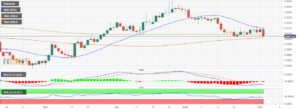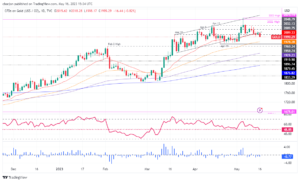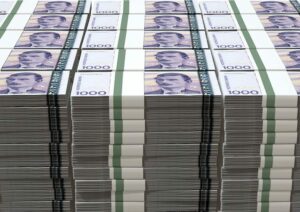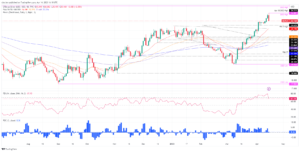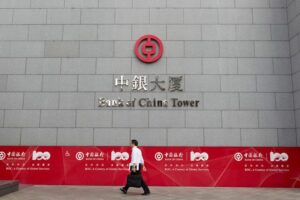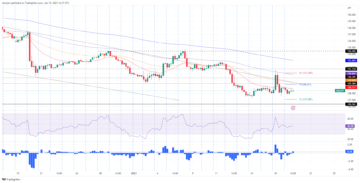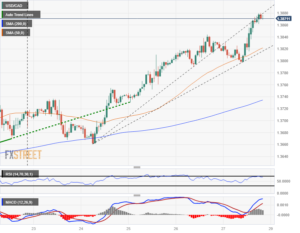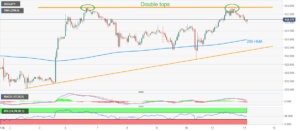
The Bank of England (BoE) announced on Thursday that it left the policy rate unchanged at 5.25% following the December policy meeting. This decision came in line with the market expectation.
Follow our live coverage of the Bank of England policy announcements and the market reaction.
Policymakers voted 6-3 in favor of the decision. Three members of the Monetary Policy Committee (MPC), Megan Greene, Jonathan Haskel and Catherine Mann, voted to raise the policy rate by 25 bps at the meeting.
In its policy statement, the BoE reiterated that the monetary policy is likely to need to be restrictive for an "extended period of time."
Key takeaways from the BoE policy statement
"The decision to increase or hold was again finely balanced."
"Will take decisions necessary to get CPI all the way back to 2%."
"Policy will need to be sufficiently restrictive for sufficiently long."
"Near-term inflation path somewhat lower than projected in November, reflecting energy prices."
"Further tightening in monetary policy would be required if there were evidence of more persistent inflationary pressures."
"BoE sees inflation just under 4.5% by end of 2023 (November forecast: Q4 CPI 4.75%), around 4.75% in January, closer to 4% in February."
"BoE staff provisionally estimate November fiscal plans will boost GDP by around 0.25% in coming years."
"Fall in services inflation caused by items that may not reflect underlying trends."
"Most of MPC majority say too early to conclude services inflation or pay growth on firmly downward path."
"Measures of inflation persistence are higher in UK than in other major advanced economies."
Market reaction to BoE policy announcements
GBP/USD gathered bullish momentum and climbed to a fresh 10-day-high above 1.2700 with the immediate reaction to the BoE policy announcements.
Pound Sterling price today
The table below shows the percentage change of Pound Sterling (GBP) against listed major currencies today. Pound Sterling was the strongest against the US Dollar.
| USD | EUR | GBP | CAD | AUD | JPY | NZD | CHF | |
| USD | -0.46% | -0.68% | -0.46% | -0.69% | -0.86% | -0.30% | -0.27% | |
| EUR | 0.48% | -0.20% | 0.03% | -0.22% | -0.38% | 0.17% | 0.20% | |
| GBP | 0.68% | 0.18% | 0.19% | -0.07% | -0.26% | 0.31% | 0.35% | |
| CAD | 0.46% | -0.02% | -0.23% | -0.25% | -0.42% | 0.12% | 0.17% | |
| AUD | 0.71% | 0.24% | 0.02% | 0.25% | -0.16% | 0.37% | 0.42% | |
| JPY | 0.85% | 0.42% | 0.23% | 0.45% | 0.18% | 0.55% | 0.60% | |
| NZD | 0.35% | -0.15% | -0.35% | -0.13% | -0.38% | -0.53% | 0.04% | |
| CHF | 0.27% | -0.19% | -0.36% | -0.16% | -0.42% | -0.60% | -0.06% |
The heat map shows percentage changes of major currencies against each other. The base currency is picked from the left column, while the quote currency is picked from the top row. For example, if you pick the Euro from the left column and move along the horizontal line to the Japanese Yen, the percentage change displayed in the box will represent EUR (base)/JPY (quote).
This section below was published as a preview of the Bank of England rate decision at 07:00 GMT.
- The UK central bank is set to hold interest rate steady at 5.25% at the final meeting of 2023.
- The Bank of England could push back against expectations of aggressive rate cuts next year.
- The Pound Sterling is poised for a big reaction to the BoE policy announcements.
In the finale of 2023, the Bank of England (BoE) is expected to keep its key interest rate unchanged for a third consecutive meeting on Thursday. The Pound Sterling (GBP) is expected to see intense volatility on the BoE policy announcements, with all eyes focusing on the United Kingdom’s (UK) central bank’s communication about the path forward on the interest rate as markets price in rate cuts in 2024.
Bank of England to extend pause into third meeting
The Bank of England is widely expected to hold the benchmark interest rate steady at 5.25% when it announces its decision at 12:00 GMT on Thursday. It’s not a “Super Thursday” as there will be no Monetary Policy Report (MPR) published nor Governor Andrew Bailey’s press conference.
With a no rate hike fully baked in this week, markets are now pricing 10% odds of a cut for the March 21 meeting, rising to nearly 45% for May 9 and nearly 90% for June 20, according to Bloomberg’s World Interest Rate Probability (WIRP).
Therefore, the language in the BoE’s policy statement is critical to gauging the interest rate outlook for next year as to when and how fast the UK central bank will cut rates. Economists and industry analysts expect the BoE to push back against expectations around rate cuts next year, especially after BoE policymakers continued to maintain a hawkish tone in their recent speeches.
BoE Deputy Governor for Markets and Banking, Dave Ramsden, said that “monetary policy is likely to be needed to be restrictive for an extended period of time to get inflation back to 2% target.” Joining the chorus, BoE policymaker Catherine Mann noted that “the prospects for more persistent inflation imply a need for tighter monetary policy.” Meanwhile, BoE Governor Andrew Bailey reiterated earlier this month that interest rates are likely to need to remain around current levels.
Rabobank’s macro strategists project the first reduction in the UK’s bank rate to take place in November 2024. “We believe the MPC will want to see compelling evidence that labor market conditions have eased in a meaningful way and that domestically generated inflation pressures have clearly cooled before starting to loosen their policy stance,” they said.
Data published by the Office for National Statistics (ONS) on Tuesday showed that the UK’s wage growth slowed in the quarter to October. However, pay growth continued to increase at a quick pace, something that could dissuade the BoE from cutting rates anytime soon.
Average Earnings excluding Bonus in the UK rose 7.3% 3M YoY in October versus September’s 7.8% increase and below 7.4% expected. Additionally, services inflation also remains very high, at 6.6%.
Meanwhile, UK economy shrank by more than expected 0.3% in October, as higher interest rates continue to squeeze household spending, the ONS data showed on Wednesday. The data, however, is unlikely to lead the BoE to signal that it is close to cutting rates, yet.
How will the BoE interest rate decision affect GBP/USD?
If the Bank of England shifts gear toward a dovish tone, acknowledging the gloomy economic outlook, GBP/USD could come under intense selling pressure. Further, a dovish vote split could also weigh on the Pound Sterling, as it would add credence to the current market pricing of rate cuts next year. Conversely, the pair’s recovery could gain momentum should the BoE stick to its hawkish rhetoric, supporting the narrative of a “higher for longer” view on interest rates.
At its November meeting, policymakers voted 6-3 in favor of the extended pause decision. Megan Greene, Jonathan Haskel and Catherine Mann voted to raise rates by 25 basis points (bps).
Dhwani Mehta, Asian Session Lead Analyst at FXStreet, offers a brief technical outlook for the major and explains: “Having found support once again at the critical 200-day Simple Moving Average (SMA) at 1.2495, GBP/USD is extending the recovery momentum. The-day Relative Strength Index (RSI) remains positioned in the bullish territory, implying more gains in the offing.”
Dhwani also outlines important technical levels to trade the GBP/USD pair: “On the upside, Pound Sterling buyers could target the static resistance near 1.2730 on a hawkish BoE pause, above which the next barrier is seen at the 1.2800 round level. Conversely, the immediate support aligns at the 21-day SMA at 1.2581, below which a test of the 200-day SMA at 1.2495 will be inevitable.”
BoE FAQs
The Bank of England (BoE) decides monetary policy for the United Kingdom. Its primary goal is to achieve ‘price stability’, or a steady inflation rate of 2%. Its tool for achieving this is via the adjustment of base lending rates. The BoE sets the rate at which it lends to commercial banks and banks lend to each other, determining the level of interest rates in the economy overall. This also impacts the value of the Pound Sterling (GBP).
When inflation is above the Bank of England’s target it responds by raising interest rates, making it more expensive for people and businesses to access credit. This is positive for the Pound Sterling because higher interest rates make the UK a more attractive place for global investors to park their money. When inflation falls below target, it is a sign economic growth is slowing, and the BoE will consider lowering interest rates to cheapen credit in the hope businesses will borrow to invest in growth-generating projects – a negative for the Pound Sterling.
In extreme situations, the Bank of England can enact a policy called Quantitative Easing (QE). QE is the process by which the BoE substantially increases the flow of credit in a stuck financial system. QE is a last resort policy when lowering interest rates will not achieve the necessary result. The process of QE involves the BoE printing money to buy assets – usually government or AAA-rated corporate bonds – from banks and other financial institutions. QE usually results in a weaker Pound Sterling.
Quantitative tightening (QT) is the reverse of QE, enacted when the economy is strengthening and inflation starts rising. Whilst in QE the Bank of England (BoE) purchases government and corporate bonds from financial institutions to encourage them to lend; in QT, the BoE stops buying more bonds, and stops reinvesting the principal maturing on the bonds it already holds. It is usually positive for the Pound Sterling.
- SEO Powered Content & PR Distribution. Get Amplified Today.
- PlatoData.Network Vertical Generative Ai. Empower Yourself. Access Here.
- PlatoAiStream. Web3 Intelligence. Knowledge Amplified. Access Here.
- PlatoESG. Carbon, CleanTech, Energy, Environment, Solar, Waste Management. Access Here.
- PlatoHealth. Biotech and Clinical Trials Intelligence. Access Here.
- Source: https://www.fxstreet.com/news/uk-interest-rate-decision-preview-boe-set-to-keep-interest-rates-on-hold-for-third-consecutive-meeting-202312140700
- :is
- :not
- 07
- 1
- 12
- 2%
- 20
- 2023
- 2024
- 25
- 31
- 32
- 33
- 39
- 41
- 7
- 9
- a
- About
- above
- access
- According
- Achieve
- achieving
- add
- Additionally
- Adjustment
- advanced
- affect
- After
- again
- against
- aggressive
- Aligns
- All
- along
- already
- also
- an
- analyst
- Analysts
- and
- Andrew
- Andrew Bailey
- Animate
- announced
- Announcements
- Announces
- ARE
- around
- AS
- asian
- Assets
- At
- attractive
- average
- back
- BAILeY
- Balanced
- Bank
- Bank of England
- Bank of England (BOE)
- Bank of England Rate Decision
- Bank Rate
- Banking
- Banks
- barrier
- base
- basis
- BE
- because
- before
- believe
- below
- Benchmark
- benchmark interest rate
- Big
- BoE
- Bonds
- Bonus
- boost
- borrow
- Box
- Bullish
- businesses
- buy
- buyers
- Buying
- by
- called
- came
- CAN
- Catherine
- caused
- central
- Central Bank
- change
- Changes
- clearly
- Climbed
- Close
- closer
- Column
- COM
- come
- coming
- commercial
- committee
- Communication
- compelling
- conclude
- conditions
- Conference
- consecutive
- Consider
- content
- continue
- continued
- conversely
- Corporate
- could
- coverage
- CPI
- credit
- critical
- currencies
- Currency
- Current
- Cut
- cuts
- cutting
- data
- Dave
- December
- decision
- decisions
- deputy
- determining
- displayed
- dissuade
- Dollar
- domestically
- Dovish
- downward
- each
- Earlier
- Early
- Earnings
- easing
- Economic
- Economic growth
- economies
- economists
- economy
- encourage
- end
- ends
- energy
- energy prices
- England
- England’s
- especially
- estimate
- EUR
- Euro
- evidence
- example
- excluding
- expanded
- expect
- expectation
- expectations
- expected
- expensive
- Explains
- extend
- extended
- extending
- extreme
- Eyes
- Fall
- Falls
- FAQ
- FAST
- favor
- February
- final
- finale
- financial
- Financial institutions
- financial system
- firmly
- First
- Fiscal
- flow
- focusing
- following
- For
- Forecast
- Forward
- found
- fresh
- from
- fully
- further
- Gain
- Gains
- gathered
- GBP
- GBP/USD
- GDP
- Gear
- generated
- get
- Global
- GMT
- goal
- Government
- Governor
- Growth
- Have
- Hawkish
- High
- higher
- Hike
- hold
- holds
- hope
- Horizontal
- household
- How
- However
- HTTPS
- if
- immediate
- Impacts
- important
- in
- In other
- Increase
- Increases
- index
- industry
- inevitable
- inflation
- inflation rate
- Inflationary
- Inflationary pressures
- institutions
- interest
- INTEREST RATE
- Interest Rates
- into
- Invest
- Investors
- involves
- IT
- items
- ITS
- January
- Japanese
- Japanese Yen
- joining
- jonathan
- jpg
- june
- just
- Keep
- Key
- Kingdom
- labor
- labor market
- language
- Last
- lead
- left
- LEND
- lending
- Level
- levels
- likely
- Line
- Listed
- live
- Long
- lowering
- Macro
- maintain
- major
- Majority
- make
- Making
- map
- March
- Market
- market conditions
- market reaction
- Markets
- May..
- meaningful
- Meanwhile
- measures
- meeting
- Megan
- Members
- module
- Momentum
- Monetary
- Monetary Policy
- monetary policy committee
- money
- Month
- more
- most
- move
- moving
- moving average
- MPC
- NARRATIVE
- National
- Near
- nearly
- necessary
- Need
- needed
- negative
- next
- no
- nor
- noted
- November
- now
- october
- Odds
- of
- Offers
- Office
- Offing
- on
- once
- or
- Other
- our
- outlines
- Outlook
- overall
- Pace
- pair
- Park
- path
- pause
- Pay
- People
- percentage
- period
- persistence
- pick
- picked
- Place
- plans
- plato
- Plato Data Intelligence
- PlatoData
- points
- poised
- policy
- policymakers
- positioned
- positive
- pound
- pound sterling
- press
- pressure
- Preview
- price
- Prices
- pricing
- primary
- Principal
- printing
- probability
- process
- project
- projected
- projects
- prospects
- published
- purchases
- Push
- push back
- QE
- QT
- quantitative
- Quantitative Easing
- Quarter
- Quick
- quote
- raise
- raising
- Rate
- Rate Hike
- Rates
- reaction
- recent
- recovery
- reduction
- reflect
- reflecting
- relative
- relative strength index
- Relative Strength Index (RSI)
- remain
- remains
- report
- represent
- required
- Resistance
- Resort
- Restrictive
- result
- Results
- reverse
- rising
- ROSE
- round
- ROW
- rsi
- Said
- say
- Section
- see
- seen
- sees
- Selling
- Services
- session
- set
- Sets
- Shifts
- should
- showed
- Shows
- sign
- Signal
- Simple
- situations
- Slowing
- SMA
- something
- somewhat
- Soon
- speeches
- Spending
- split
- Squeeze
- Staff
- stance
- Starting
- starts
- Statement
- statistics
- steady
- sterling
- Stick
- Stops
- strength
- strengthening
- strongest
- substantially
- support
- Supporting
- system
- table
- Take
- Takeaways
- Target
- Technical
- territory
- test
- than
- that
- The
- the UK
- the United Kingdom
- their
- Them
- There.
- they
- Third
- this
- this week
- three
- thursday
- tightening
- tighter
- time
- to
- today
- TONE
- too
- tool
- top
- toward
- trade
- Trends
- Tuesday
- Uk
- UK Central Bank
- under
- underlying
- United
- United Kingdom
- unlikely
- Upside
- us
- US Dollar
- usually
- value
- Versus
- very
- via
- View
- Volatility
- Vote
- voted
- wage
- want
- was
- Way..
- weaker
- Wednesday
- week
- weigh
- were
- when
- which
- while
- Whilst
- widely
- will
- with
- world
- would
- year
- years
- Yen
- yet
- you
- zephyrnet

